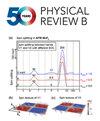Second-order nonlinear piezo-optic properties of single crystal lithium niobate thin films
IF 3.7
2区 物理与天体物理
Q1 Physics and Astronomy
引用次数: 0
Abstract
Stress plays a crucial role in thin films and layered systems, and thus significantly influences the material's electrical, mechanical and (nonlinear) optical responses. Despite lithium niobate's wide applicability as a nonlinear optical material, the impact of mechanical stress on its nonlinear optical properties is not well characterized. In this work, we systematically study both experimentally and theoretically, the nonlinear optical responses of thin film lithium niobate (TFLN) single crystals. Compressive and tensile stress is applied in our experiment using a piezodriven strain cell. We then record the second-harmonic-generated (SHG) response in back-reflection geometry, and compare these results to theoretical modeling using density functional theory (DFT). Both methods consistently reveal that uniaxial stress induces changes of the nonlinear optical susceptibility of certain tensor elements on the order of up to 1 pm/(V GPa). The exact value depends on the tensor element that is addressed in our SHG analysis, on the crystal orientation, and also whether using compressive or tensile stresses. Furthermore, a lowering of the crystal symmetry when applying stress along the x or单晶铌酸锂薄膜的二阶非线性压电光学特性
应力在薄膜和层状系统中起着至关重要的作用,因此显著影响材料的电、机械和(非线性)光学响应。尽管铌酸锂作为一种非线性光学材料具有广泛的适用性,但机械应力对其非线性光学性能的影响尚未得到很好的表征。本文系统地研究了薄膜铌酸锂(TFLN)单晶的非线性光学响应。压应力和拉应力在我们的实验中使用了一个压电驱动的应变单元。然后,我们记录了反向反射几何中的二次谐波(SHG)响应,并将这些结果与使用密度泛函理论(DFT)的理论建模进行了比较。两种方法一致表明,单轴应力引起某些张量元的非线性光学磁化率的变化,其量级高达1 pm/(V GPa)。确切的值取决于我们在SHG分析中处理的张量元素,晶体取向,以及是否使用压缩或拉伸应力。此外,当沿着x或y晶体轴施加应力时,通过在应变晶体内出现新的非线性光学张量元,可以观察到晶体对称性的降低。2025年由美国物理学会出版
本文章由计算机程序翻译,如有差异,请以英文原文为准。
求助全文
约1分钟内获得全文
求助全文
来源期刊

Physical Review B
物理-物理:凝聚态物理
CiteScore
6.70
自引率
32.40%
发文量
0
审稿时长
3.0 months
期刊介绍:
Physical Review B (PRB) is the world’s largest dedicated physics journal, publishing approximately 100 new, high-quality papers each week. The most highly cited journal in condensed matter physics, PRB provides outstanding depth and breadth of coverage, combined with unrivaled context and background for ongoing research by scientists worldwide.
PRB covers the full range of condensed matter, materials physics, and related subfields, including:
-Structure and phase transitions
-Ferroelectrics and multiferroics
-Disordered systems and alloys
-Magnetism
-Superconductivity
-Electronic structure, photonics, and metamaterials
-Semiconductors and mesoscopic systems
-Surfaces, nanoscience, and two-dimensional materials
-Topological states of matter
 求助内容:
求助内容: 应助结果提醒方式:
应助结果提醒方式:


